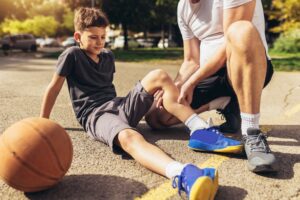
1. Cuts and Scrapes
Minor cuts and scrapes are among the most frequent injuries in schools, often occurring during playtime, sports, or practical lessons.
How to treat a cut or scrape:
- Wash hands before treating the wound.
- Gently clean the area with running water to remove dirt.
- Apply a sterile dressing or plaster to protect the wound.
- If bleeding continues, apply firm pressure with a clean cloth.
For larger wounds that won’t stop bleeding, seek medical attention. Schools should always have a stocked first aid kit available.
2. Nosebleeds
Nosebleeds are common in children due to dry air, minor injuries, or even excessive nose picking.
How to stop a nosebleed:
- Ask the student to sit down and lean forward slightly (not backwards).
- Pinch the soft part of the nose just above the nostrils.
- Keep holding the nose for about 10 minutes.
- Encourage the student to breathe through their mouth and avoid speaking.
If the nosebleed lasts longer than 20 minutes, seek medical advice.
3. Sprains and Strains
Sports and playground activities can lead to twisted ankles, sprains, and minor muscle strains.
How to manage a sprain:
- RICE method: Rest, Ice, Compression, and Elevation.
- Apply a cold pack wrapped in a cloth for 10-15 minutes.
- Support the injured limb with a bandage if needed.
- If swelling or pain persists, seek medical attention.
Sports teams and PE teachers should ensure students know how to recognise and manage sprains safely.
4. Head Bumps and Concussions
Head injuries can range from minor bumps to more serious concussions.
How to treat a head bump:
- Apply a cold compress to the area to reduce swelling.
- Monitor the student for dizziness, nausea, or confusion.
- If symptoms persist or worsen, seek urgent medical attention.
For any suspected concussion, students should not return to physical activity until cleared by a medical professional.
5. Allergic Reactions
Allergies are a growing concern in schools, with reactions ranging from mild to life-threatening.
Signs of an allergic reaction:
- Skin rashes or hives
- Swelling of the face, lips, or throat
- Difficulty breathing
- Dizziness or fainting
How to respond:
- Give antihistamines for mild reactions (if prescribed).
- If anaphylaxis is suspected, use an adrenaline auto-injector immediately.
- Call 999 and monitor breathing.
Schools should keep emergency allergy action plans and ensure staff are trained in using auto-injectors. ProTrainings UK offers Anaphylaxis Awareness courses for staff and students.
6. Burns and Scalds
Hot drinks, cooking lessons, or science experiments can sometimes lead to burns.
How to treat a burn:
- Run cool water over the burn for at least 10 minutes.
- Do not use ice, butter, or creams.
- Cover with a clean, non-stick dressing.
- Seek medical attention for severe burns.
Burns should always be assessed carefully, and medical advice should be sought for any significant injuries.
7. Insect Stings and Bites
Outdoor activities can sometimes lead to insect bites or stings, causing pain and swelling.
How to treat insect stings:
- Remove the stinger (if present) by scraping it off with a card.
- Apply a cold compress to reduce swelling.
- If allergic symptoms appear, follow anaphylaxis treatment steps.
For students with severe allergies, schools should have clear emergency plans in place.
Why First Aid Training is Essential for Schools
By equipping students and staff with first aid knowledge, schools create a safer environment and empower individuals to respond confidently in emergencies.
Benefits of first aid training:
- Quick and effective response to common injuries.
- Reduced risk of complications from untreated injuries.
- Increased student confidence and leadership skills.
Schools can sign up for free Student First Aid training to ensure students know how to handle these everyday situations.
Conclusion
Minor injuries are part of school life, but knowing how to treat them properly can make a big difference. With the right training and supplies, students and staff can ensure a quick and effective response to common injuries.
To access free student first aid training, visit www.studentfirstaid.co.uk. For professional first aid courses and certifications, explore ProTrainings UK.
